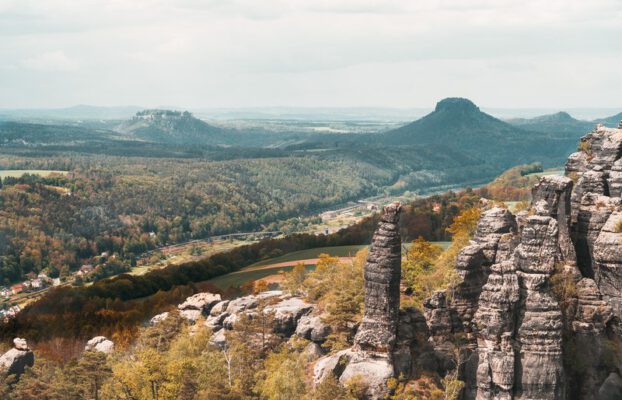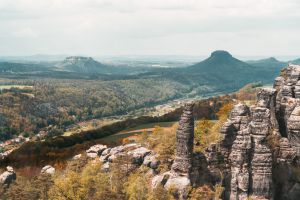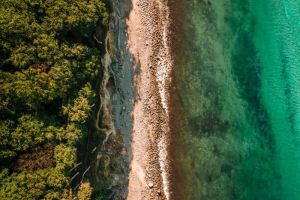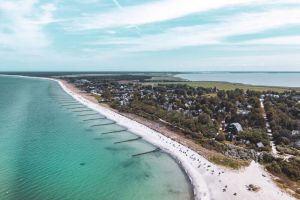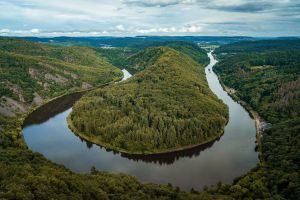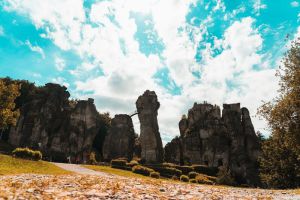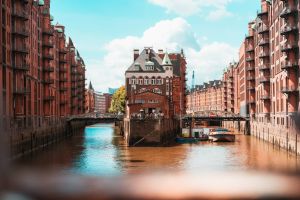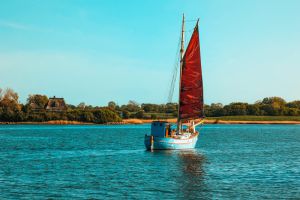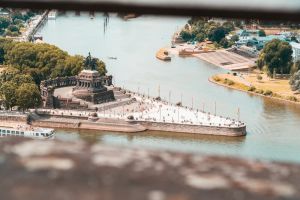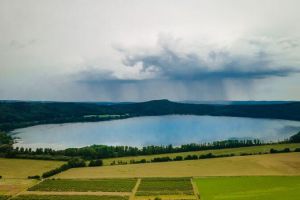Wow! It’s hard to believe that such a landscape exists in Germany. The Saxon Switzerland National Park in the Elbe Sandstone Mountains really is one of the absolute natural highlights in Germany. In this article, I’ll show you the best Saxon Switzerland sights and tell you the best way to get to the famous Bastei Bridge.
Mighty rocks towering over the otherwise flat plain, deep echo-friendly gorges and, in between, the calmly flowing Elbe, largely spared from shipping traffic – the landscape in the Elbe Sandstone Mountains to the east of Dresden is simply picturesque – in the truest sense of the word. Many painters have found their inspiration here and have repeatedly visited this natural work of art, which is unique in the whole of Europe. Probably the most famous of them is Casper David Friedrich from Greifswald. One of his most famous paintings – The Wanderer in the Sea of Fog – is strongly reminiscent of the landscape in the Elbe Sandstone Mountains.
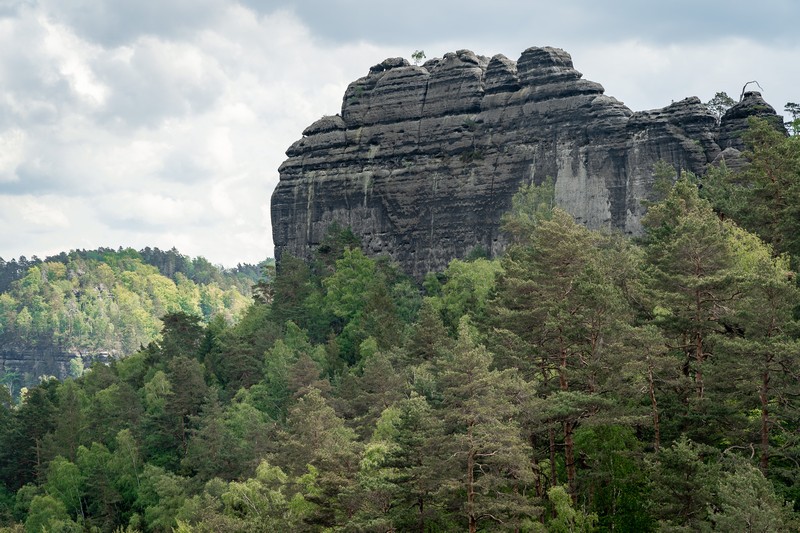
That is why there is even a hiking trail here called the Malerweg, which stretches over many different stages. Incidentally, the name “Saxon Switzerland” comes from two Swiss artists (Adrian Zingg and Anton Graff) who taught at the Dresden Academy of Art in the 18th century and who felt reminded of their homeland here.
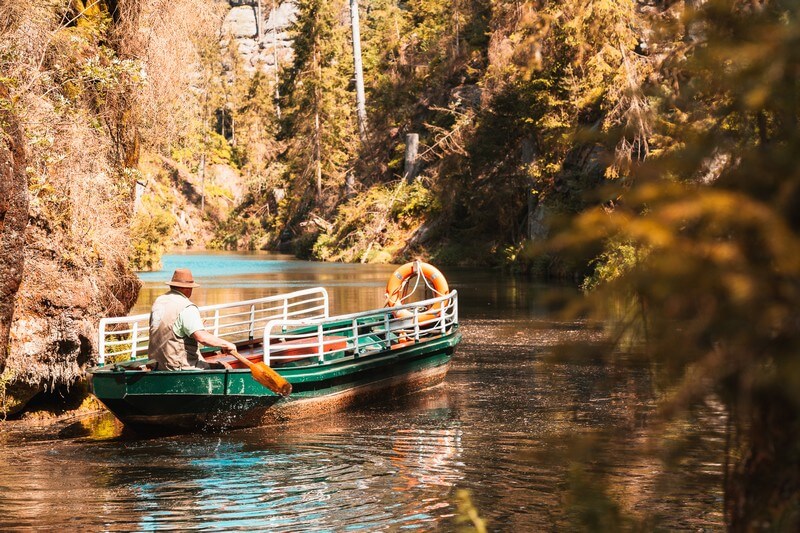
The region reminded me strongly of the stories of Karl May and the Wild West – above all, of course, the stories of Winnetou and Old Shatterhand.
You can also find the sights mentioned in this article here on the map:
What exactly is Saxon Switzerland?
Saxon Switzerland is the German part of the Elbe Sandstone Mountains, which stretches all the way to the Czech Republic (where it is known as Bohemian Switzerland).
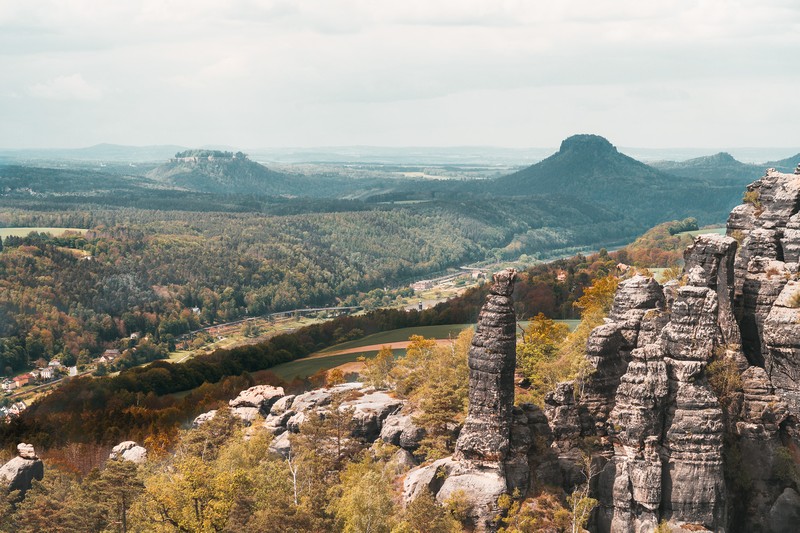
The Saxon Switzerland National Park is located within the Saxon Switzerland landscape conservation area. There are 2 separate parts of the national park:
- The famous Bastei Bridge is located in the western part.
- The eastern part is larger and stretches along the Czech border. Among other things, the Schrammsteine are located here.
- Both parts together have an area of 93.5 km².
The entire area with the actual national park plus the landscape conservation area is called the Saxon Switzerland National Park Region and has a total area of around 380 km².
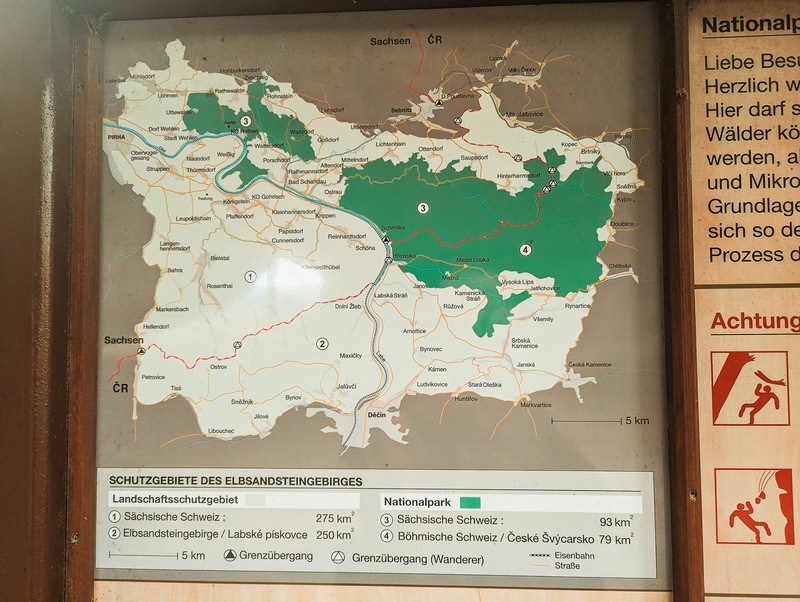
Many of the Saxon Switzerland sights in this article are located directly in the national park, but some are only within the protected landscape area. But that doesn’t really matter, because the whole region here is simply a dream full of breathtaking panoramas with spectacular rock formations and gorges.
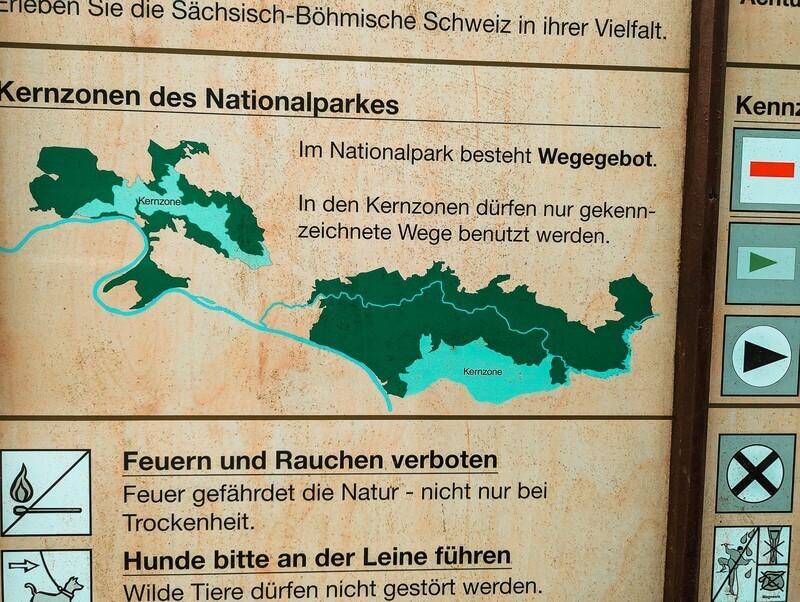
The largest towns in Saxon Switzerland are Stadt Wehlen, Königstein, Bad Schandau and Pirna in the far west. Many tourists also find accommodation here from which they start their tours.
How long should I stay in Saxon Switzerland?
Many tourists come to Saxon Switzerland over the weekend. Of course, that’s not enough if you want to see all the sights of Saxon Switzerland.
In one week you can actually see most of it and, depending on your fitness level, go on 3 or 4 extensive hikes. But you’ll be pretty exhausted afterwards :)
I spent 8 days here myself and didn’t manage to see everything. The good thing is that you can come to this picturesque area more often and always discover something new.
Saxon Switzerland is very well developed for tourism. There are many great hotels, campsites and other accommodation options. The hiking trails are well maintained, nature is protected and the locals here are very friendly and helpful.
But enough of the introductory words. Now let’s get straight to the best sights in Saxon Switzerland:
1. Bastei bridge
The Bastei Bridge is by far the most visited attraction in Saxon Switzerland. And although the place here is beautiful, it is often overcrowded and you can really speak of overtourism here. This can be seen from the fact that a huge complex with a hotel, beer garden, restaurants and all kinds of “food stalls” has been built next to the bridge on the summit. On some days it is so crowded that it looks as if a colony of penguins is squeezed together across the bridge.
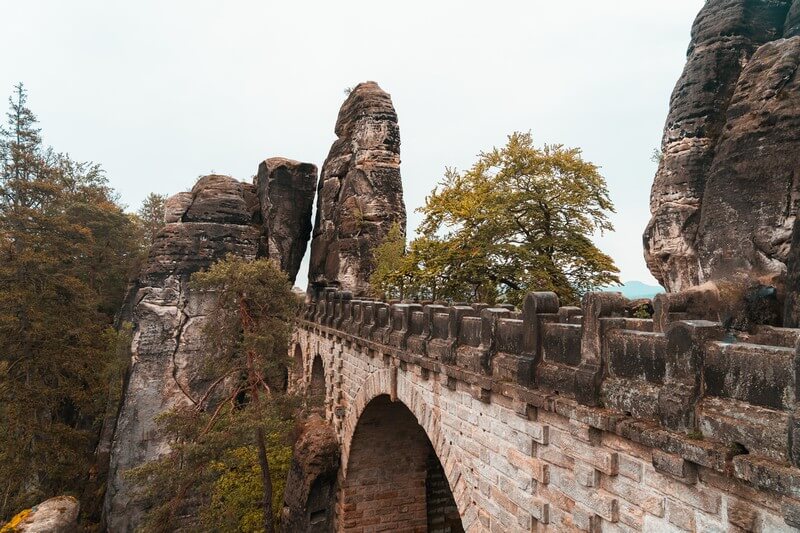
In my opinion, you should therefore avoid visiting here, especially at weekends and on public holidays. I recommend coming here on less busy days of the week.
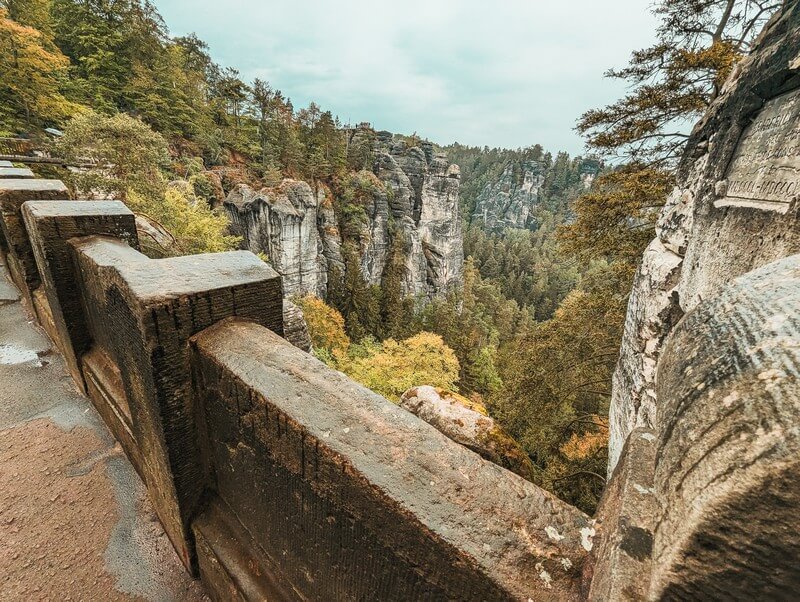
The most popular route to the Bastei Bridge is a circular tour that starts and ends in Rathen. It first takes you up along the rock faces, past several viewpoints and the Neurathen rock castle to the bridge and the panoramic restaurant and beer garden. Then it’s back down again, along the impressive 3 km hiking trail through the Schwedenlöcher gorge and past the Amselsee lake.
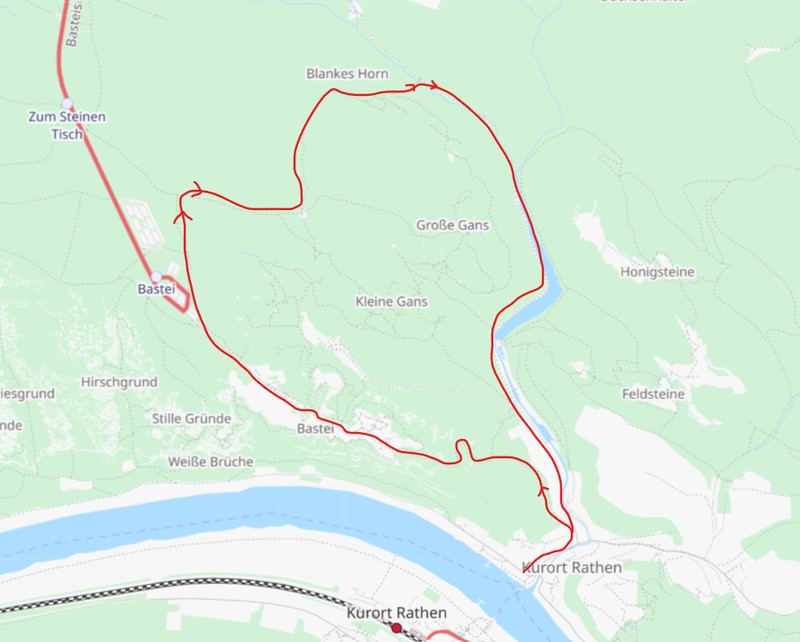
Entry to the bridge is free. You can simply walk across it. But there is an entrance fee of €2.50 for the Neurathen rock castle.
2. Schwedenlöcher (Swedish holes)
The Schwedenlöchern are an impressive gorge near Rathen and the Bastei Bridge. Approx. 700 steps and a well-developed path lead you through the gorge for around 1 km.
The name comes from the time of the Thirty Years’ War, when the locals hid here from the plundering Swedish army. The hiking trail along the Schwedenlöcher was only recently renovated and was closed for several months. However, the construction work has now been completed.
3. Lake Amselsee
Many tourists associate a visit to the lake Amselsee, which is only 500 meters long, with the Bastei Bridge and the Schwedenlöcher. You can reach the idyllically situated reservoir from Rathen in around 15 minutes on foot.
Guests can take a few laps around the lake in the small green boats for a few euros at the boat rental point and take photos of the beautiful scenery. There is also a small kiosk called Wanderrast at the boat hire, which is run by TV chef Verena Leister.

4. Health resort Rathen
Rathen is probably one of the most visited places in Saxon Switzerland, because to get to the Bastei Bridge, you have to take the ferry across the Elbe to the center of Rathen.
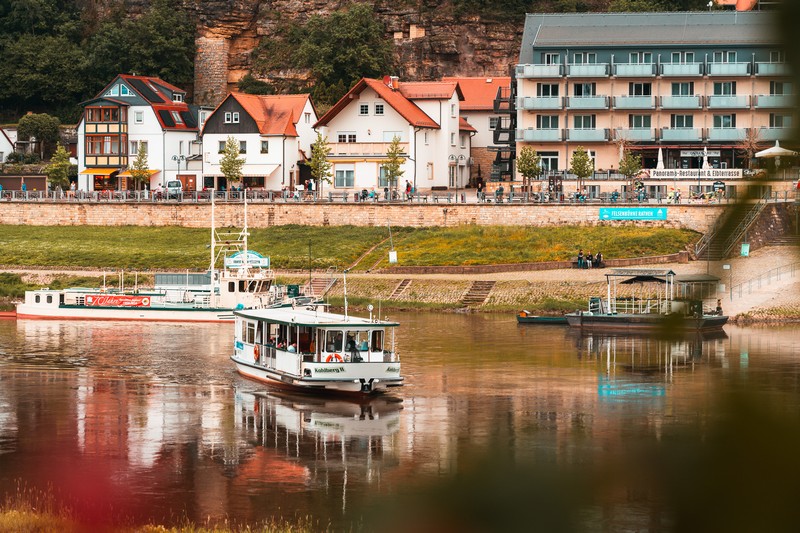
There are numerous restaurants, cafés and bars here. Rathen is a popular starting point for hikes and is also very popular for overnight stays.
The Felsenbühne Rathen is also famous. It is an open-air theater that was built back in 1936. The 2,000-seat stage is the only natural stage in a national park in Germany. There are numerous performances here from May to September, including classics such as “Winnetou” and “Der Freischütz”.
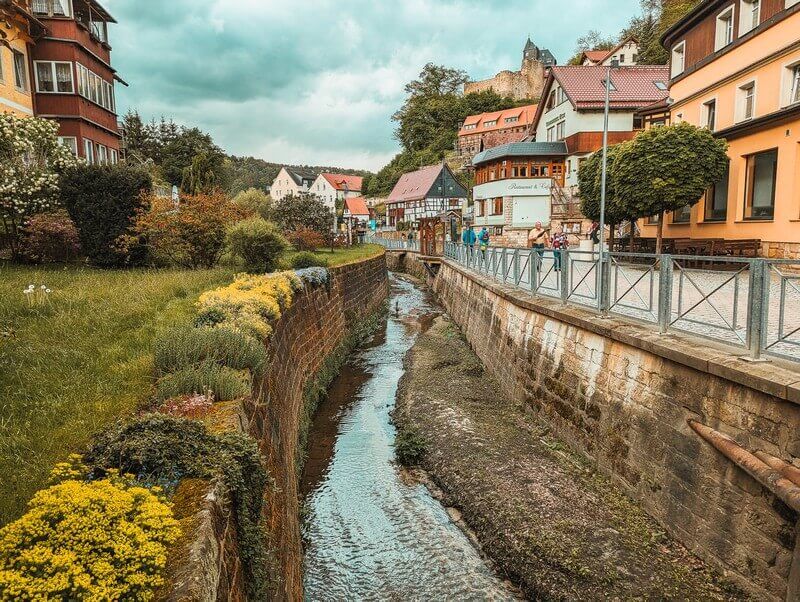
The rhododendron park on one of Rathen’s slightly higher plateaus is a somewhat lesser-known attraction. You can tell that the first plants were cultivated here at the end of the 19th century simply by their size. Partly overgrown, winding paths lead you past some magnificent rhododendron specimens, which shine beautifully in all kinds of colors, especially during the flowering season in May and June. There are also all kinds of other plants, such as rare deciduous trees, ferns, an old magnolia, exotic conifers and various flowering shrubs.
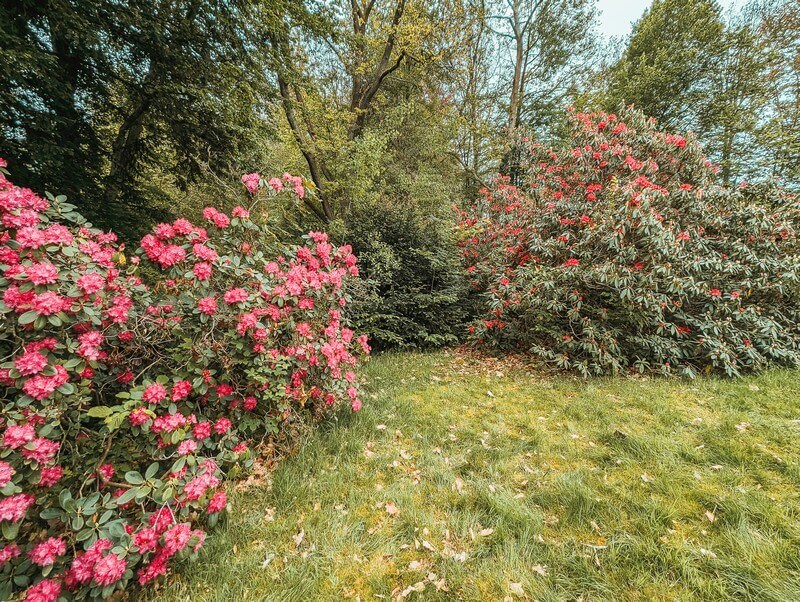
The “Kleine Bastei” viewpoint is just a stone’s throw from the park. Once you have made the effort to walk up the mountain, you should not miss out on this fantastic view over the Elbe valley.
5. Town of Wehlen
Stadt Wehlen is a popular town with small-town flair on the Elbe in Saxon Switzerland. You can stroll along the riverbank, stop off at one of the restaurants or stroll through the alleyways of the town center to the market square with its church. There are also 2 ice cream parlors and a few restaurants here.
A small hiking trail leads from the market up to the castle ruins. It takes about 10 minutes to reach the top, from where you have a great view over Wehlen and the Elbe valley.
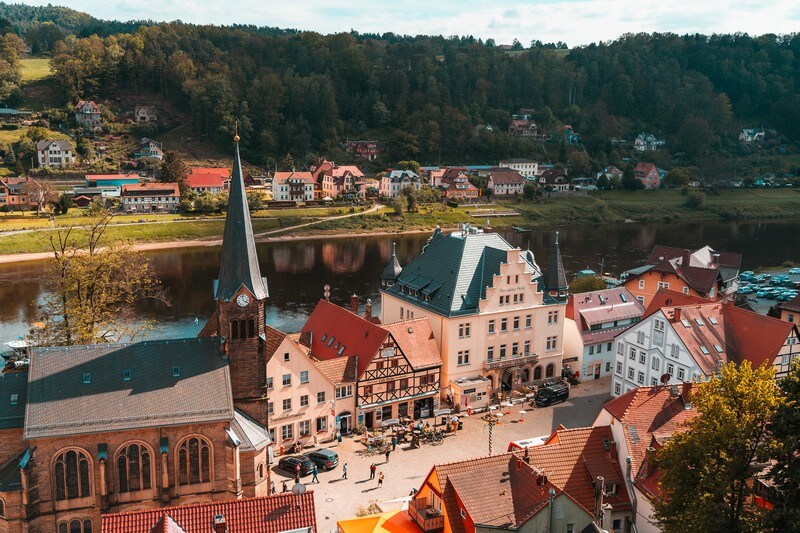
Wehlen is also known for the oldest and largest paddle steamer fleet in the world. You can even get as far as Dresden or Meisen from here. Here you can find the departure times of the various steamers from Wehlen.
6. Fortress Königstein
Alongside the Bastei Bridge, Königstein Fortress is probably one of the most famous sights in Saxon Switzerland. You can see the striking rock with its fortress wall and castle from afar.
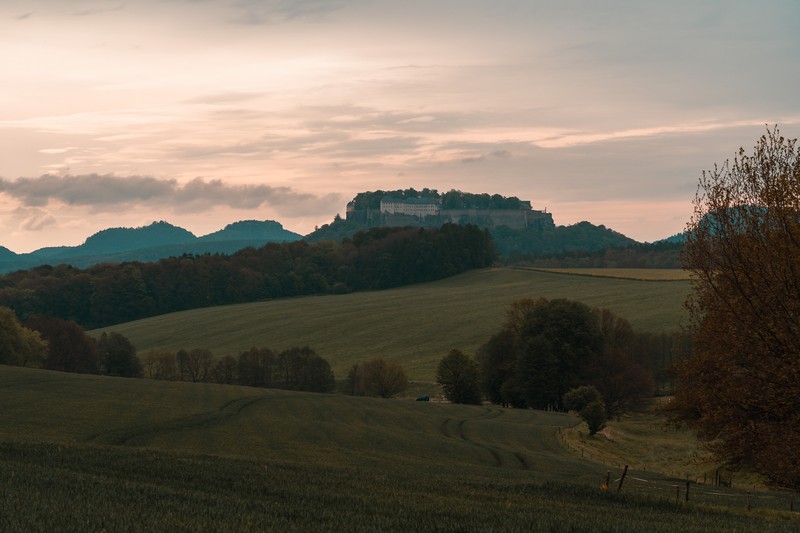
Some people told me before my visit to Saxon Switzerland that the €15 entrance fee for the fortress was far too expensive and not worth it. But I can’t confirm that at all. Sure, you come to the national park to hike, but there are so many exciting things to discover at the fortress that you could spend a whole day there. Königstein Fortress is a great option, especially on rainy days when hiking is uncomfortable.
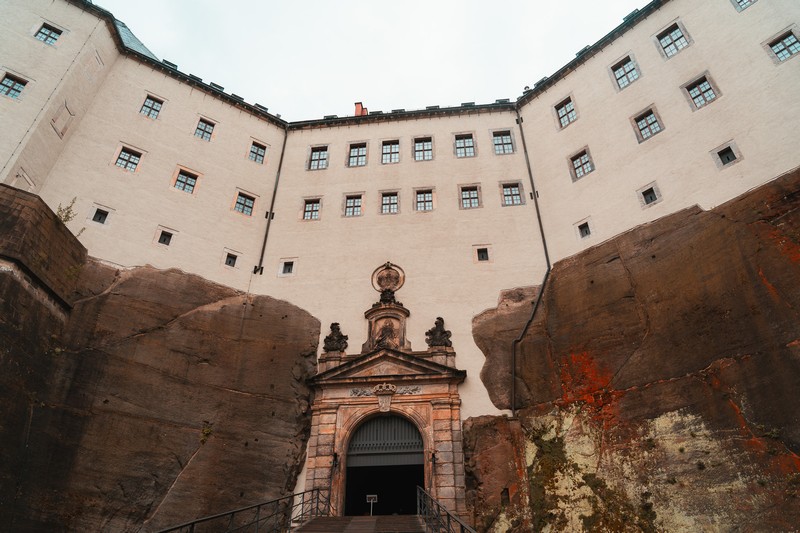
There are numerous museums and exhibitions here where you can learn a lot about the history and life of the fortress and the region. Almost all the buildings are accessible. Highlights for me were the really deep well, the 238,600 liter giant barrel of Augustus the Strong and the view over the Elbe valley and the countryside from Friedrichsburg Castle .
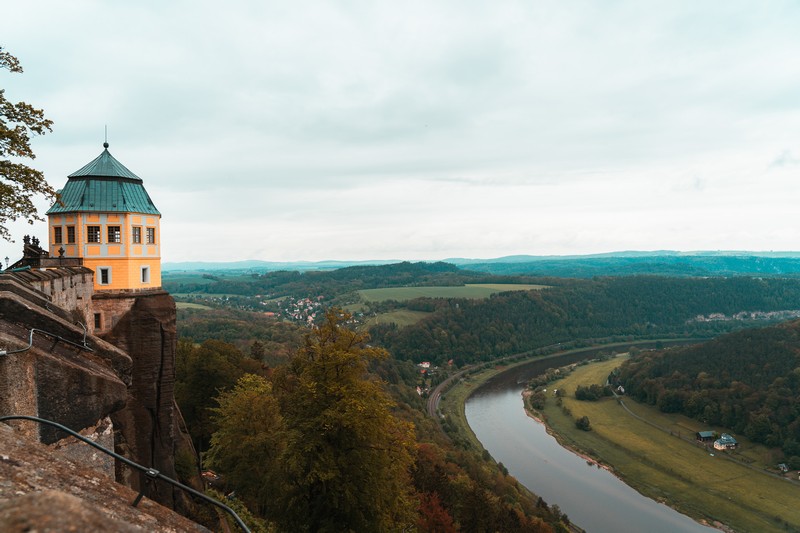
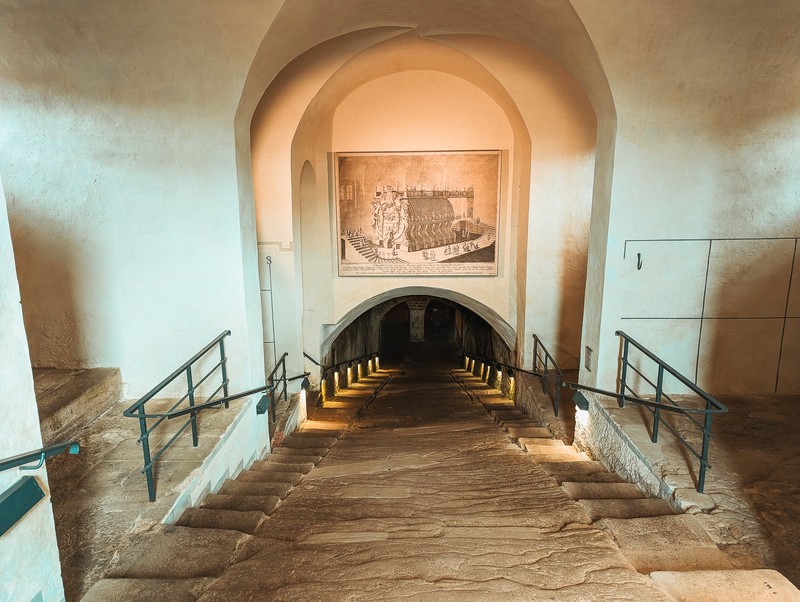
It is also worth walking all the way along the fortress wall and enjoying the various panoramic views in all directions.
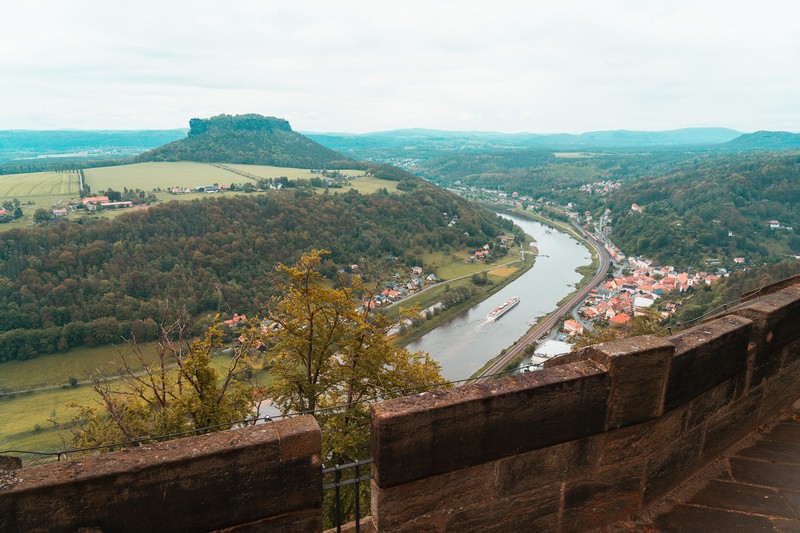
There are also several restaurants and cafés on the grounds where you can recharge your batteries after exploring the fortress.
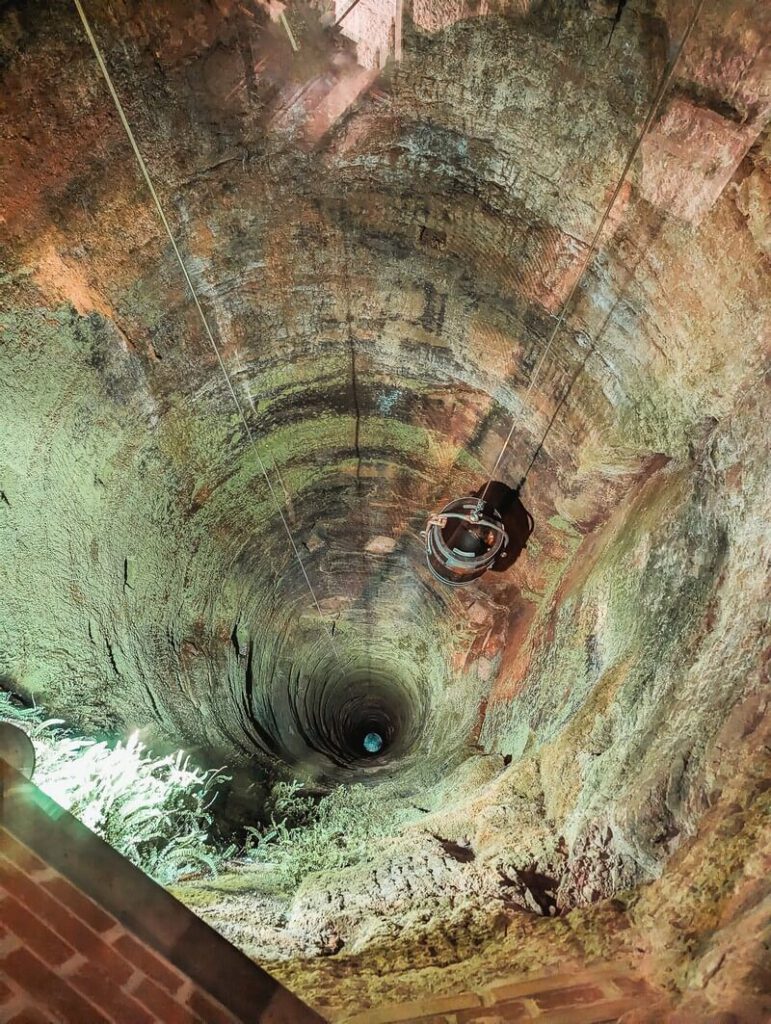
7. Lohmen
Lohmen is a small, inconspicuous village near the Bastei Bridge. Although many visitors make a pilgrimage mainly to this bridge, the somewhat lesser-known Saxon Switzerland sights in Lohmen are also worth a visit.
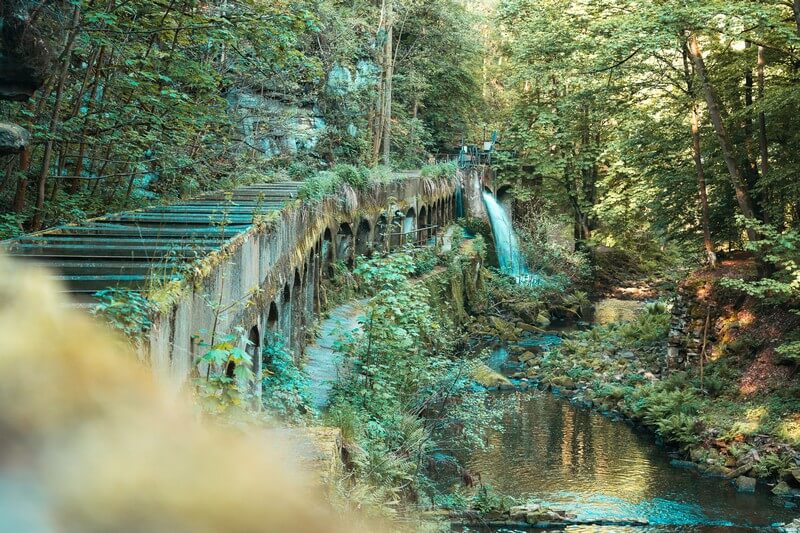
The Niezelgrund hydroelectric power station in the Lohmen gorge is an old plant from the 19th century that still supplies over 300 households with energy today.
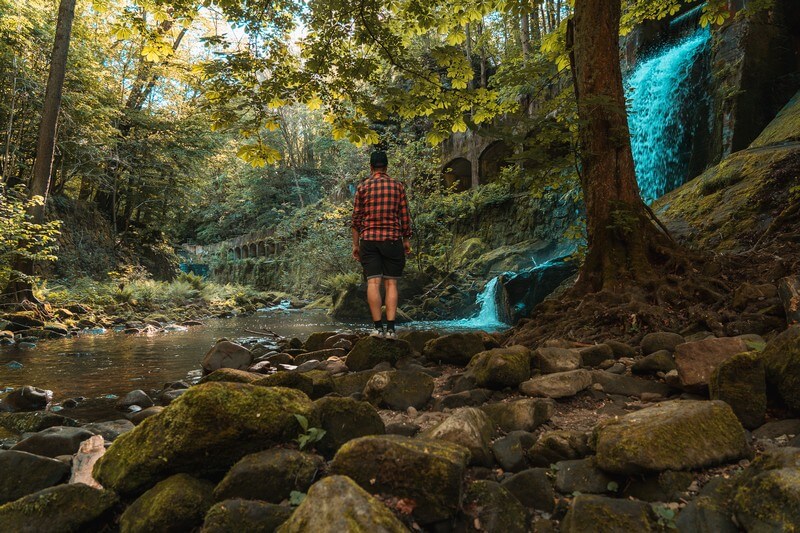
The water runs along an aqueduct-like channel and then falls down in a waterfall. It is particularly mystical here in the morning and few other hikers come here.
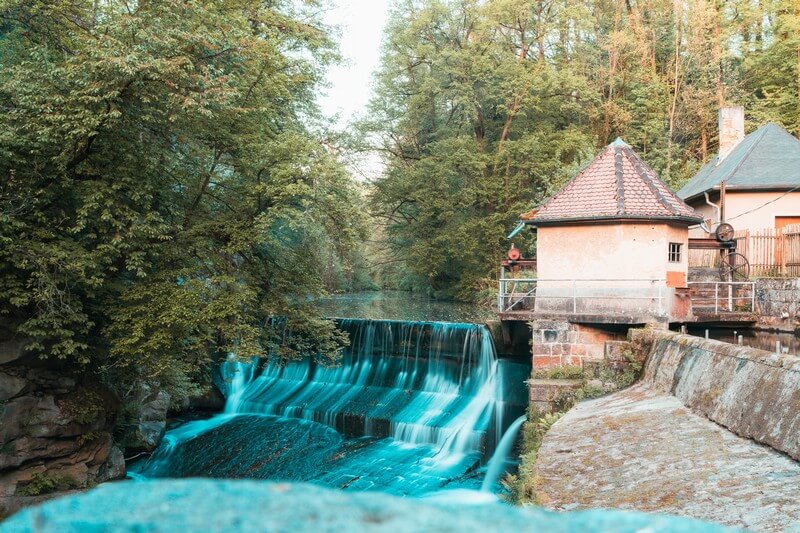
8. Hohnstein Castle
The medieval complex of Hohnstein Castle is located on a rocky plateau above the Polenztal valley. From the castle, you have a fantastic panoramic view of the entire region. You can see the furthest from the castle tower, which you can climb for free. You can also enjoy the view over coffee and cake on the castle terrace.
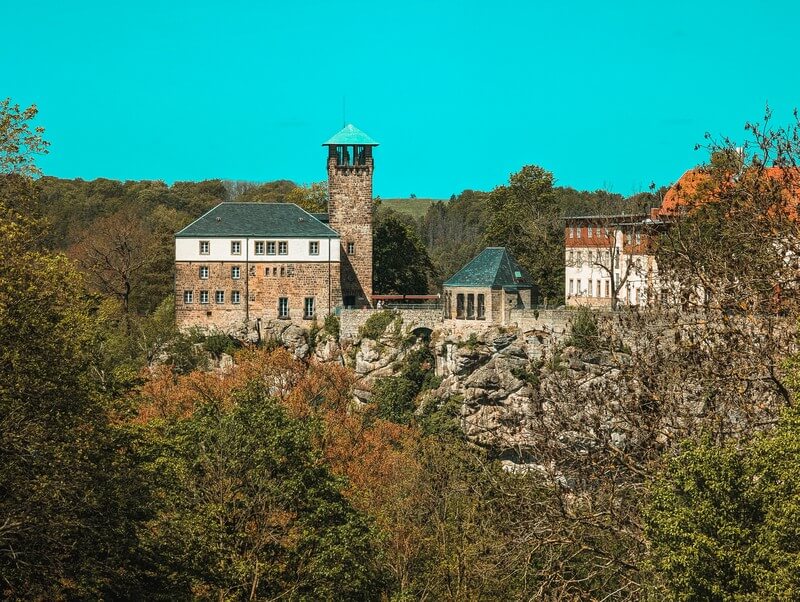
A great hiking trail in the region is the nature trail, which starts at Hohnstein Fortress and takes you through the Wolfsschlucht gorge and the Polenztal valley . I found the many signs along the trail fascinating, which give you lots of information about the respective places and the history of the region – there are 56 in total.
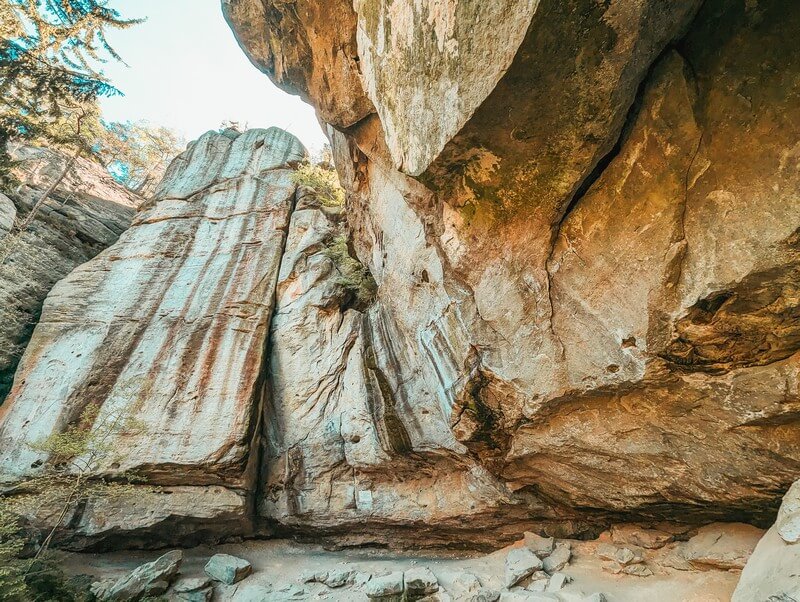
Among other things, you will learn that there used to be a bear garden here (yes, you read that right, with “ä” and not “ee”) where bears were kept. Quirky, isn’t it?
9. Kleinsteinhöhle (Small stone cave)
From the Kleinstein Cave, you can enjoy one of the best sunsets in Saxon Switzerland. The cave is also very popular with climbers.
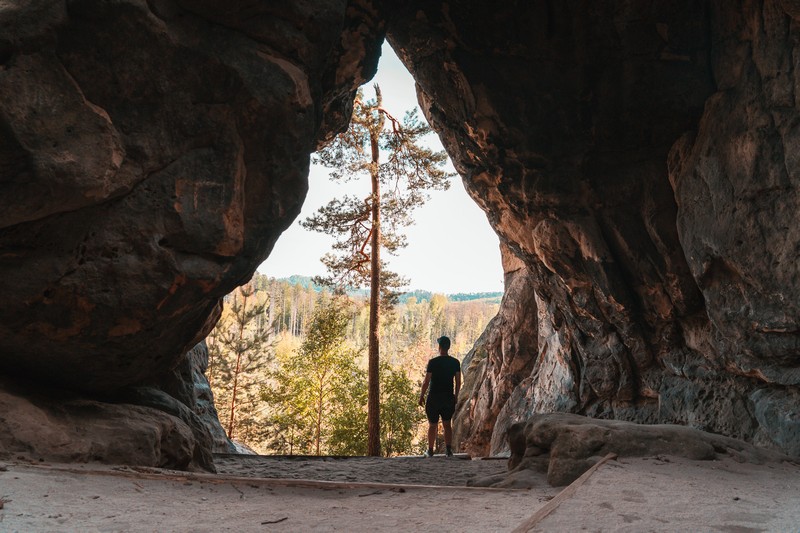
You can reach the Kleinstein Cave in about 20 minutes on foot from the Sturmbauers Eck parking lot. A few ladders also lead up from the cave to a viewing point.
10. Obere Schleuse – Kirnitzschklamm (Kirnitzsch Gorge )
The Obere Schleuse is a lock on the Kirnitzsch river, from where you can also travel a slightly wider section of the Kirnitzsch on a raft boat. Many tourists do this, because despite the fact that the bad weather conditions in recent years have caused a lot of trees to die here, the Kirnitzsch Gorge by boat is an absolute highlight.
A ticket for this costs €9 and you can buy it directly at the upper lock at the Rindenhütte. There is also a kiosk selling food and drinks.
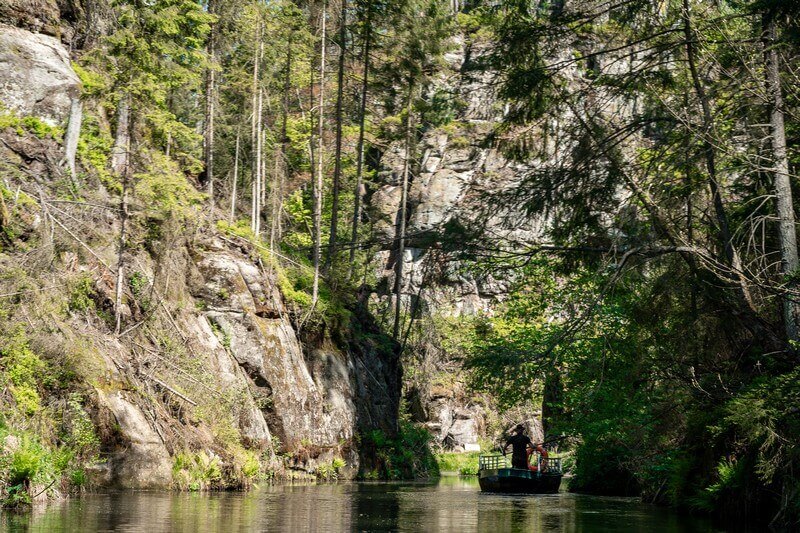
A driver will take you across the water almost silently. There is also plenty of information about the history of the region and the raftsmen, as well as information about the flora and fauna and the strange formations of the surrounding rocks – and of course a joke or two à la Fips Asmussen.
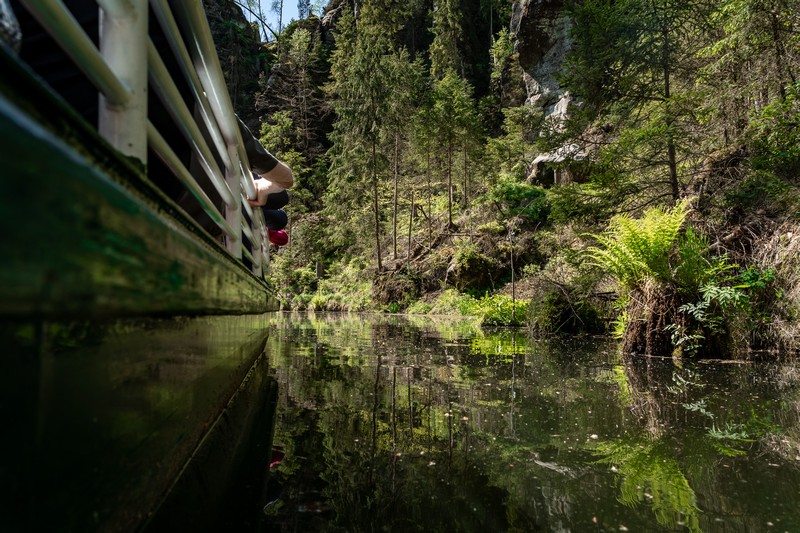
To get back to the lock, you simply walk a small section of the famous rafting trail back along the river. But even if you want to hike further, you have plenty of options from the end of the boat trip. Theoretically, you could also hike the rafting trail all the way to Bad Spandau, just like the raftsmen who once transported the timber felled in the Elbe Sandstone Mountains downstream into the Elbe via the Kirnitzsch.
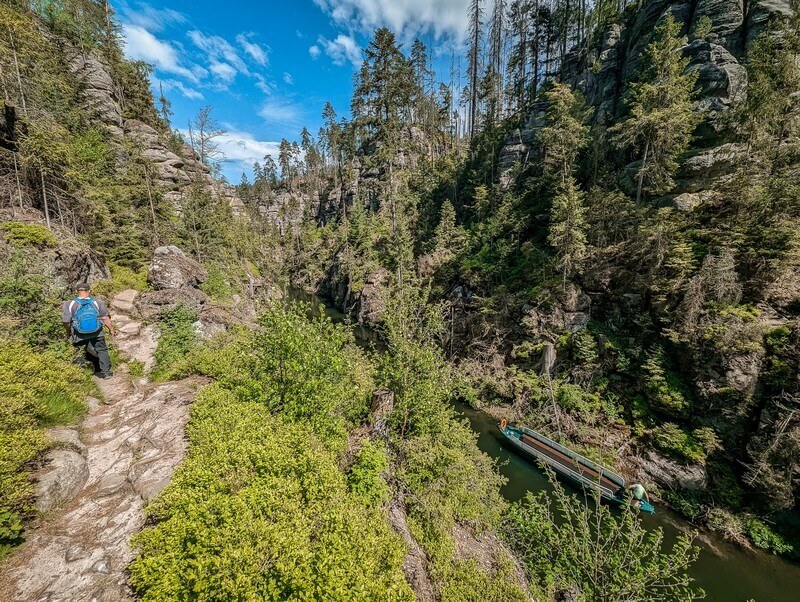
The border between Germany and the Czech Republic has remained unchanged along the Kirnitszsch since 1451. This can still be seen on the boat tour by the border stones covered in moss.
11. Königsplatz
In my opinion, Königsplatz is one of the most beautiful vantage points in the national park because you can see the full extent of nature in the national park from there. The Saxon King Friedrich August II, after whom the square is named and who liked to spend time here, probably already recognized this.
I am standing on a cliff of the 463-meter-high Königsplatz. An almost magical place. The wind is roaring without end. It feels like I’m standing in the middle of a squall. If I don’t hold on tight, I’ll fly off the ledge. It’s a good thing my hair is cut short. Otherwise I wouldn’t be able to see anything. In the distance, I can see the mountains of Saxon and Bohemian Switzerland towering like cylinders in the landscape. Branches blow and bang against each other. It sounds as if a doe has just died. The leaves on the ground are whirled up by a gust of wind and fly through the air like sharp razor blades.
from my travel notes
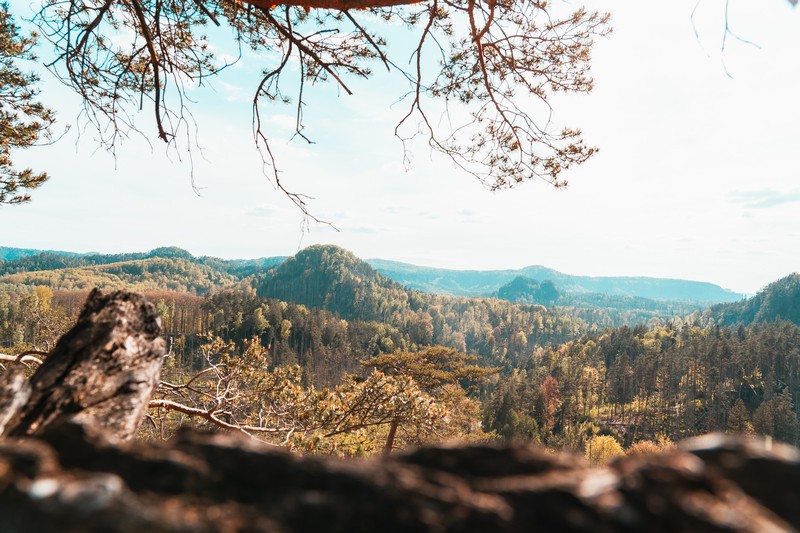
With the view here over the vast landscape, I can somewhat understand the engraving carved into the stone:
Man walks on the ruins of dark prehistoric times. Perhaps a Titan wrestled here with the almighty Zeus. It wants to prepare the downfall of the god in the battle for heaven: See the gruesomely clear evidence on the cracked rock.
Unknown
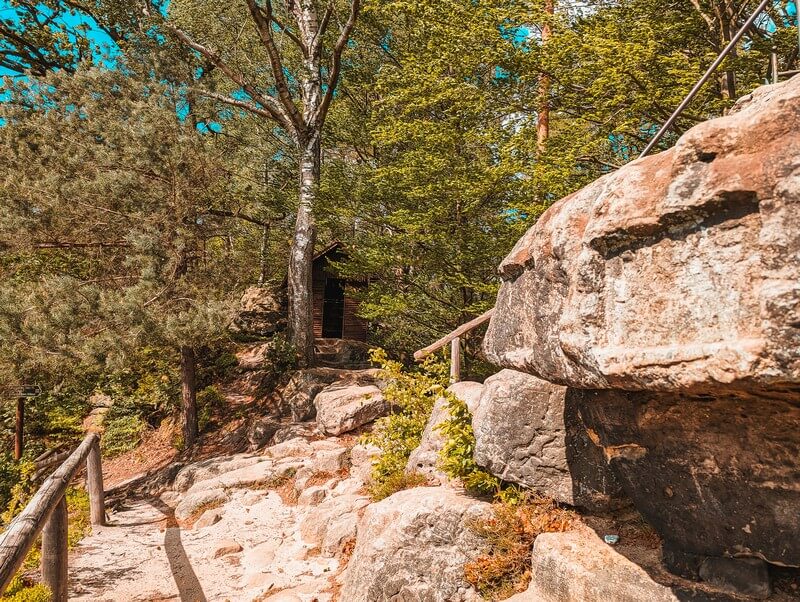
12. Brüdersteine (brother stones)
Not far from Königsplatz are the Brüdersteine, which stand together like brothers. This is one of the quieter, but by no means less exciting viewpoints in the national park.
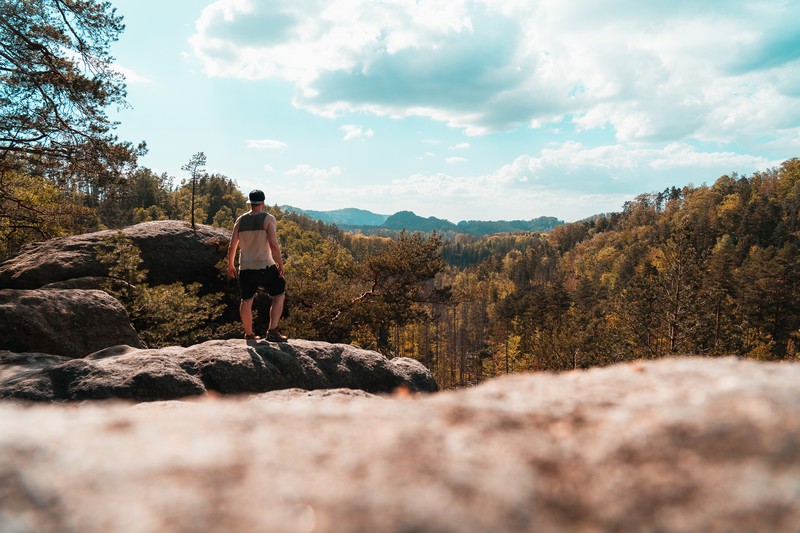
13. Sommerwand (summer wall)
From most vantage points in the eastern part of Saxon Switzerland National Park, you will be able to recognize this row of rocks – the Sommerwand.
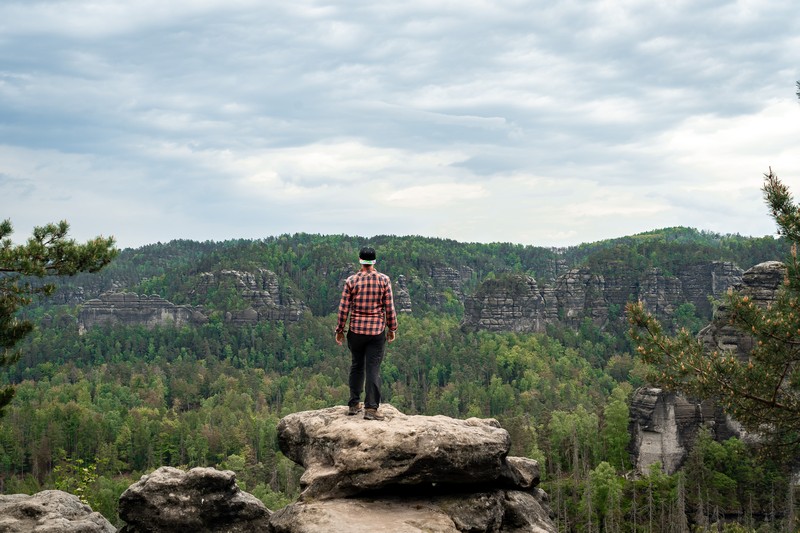
However, there is also a hiking trail that takes you directly below the rock formation.
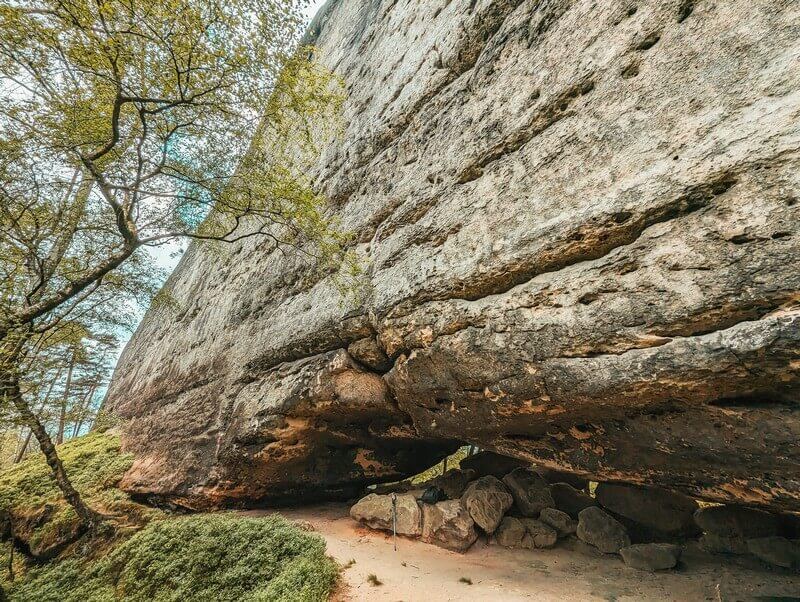
14. Weberschlucht und Webergrotte
This Saxon Switzerland attraction is not so easy to reach because it is located deep inside the national park and you first have to hike through the Gorge “Weberschlucht” to reach the Grotto “Webergrotte”, which is somewhat hidden in the forest. However, the Grotto, which has been carved 17 m deep into the rock by erosion, is a fantastic natural spectacle.
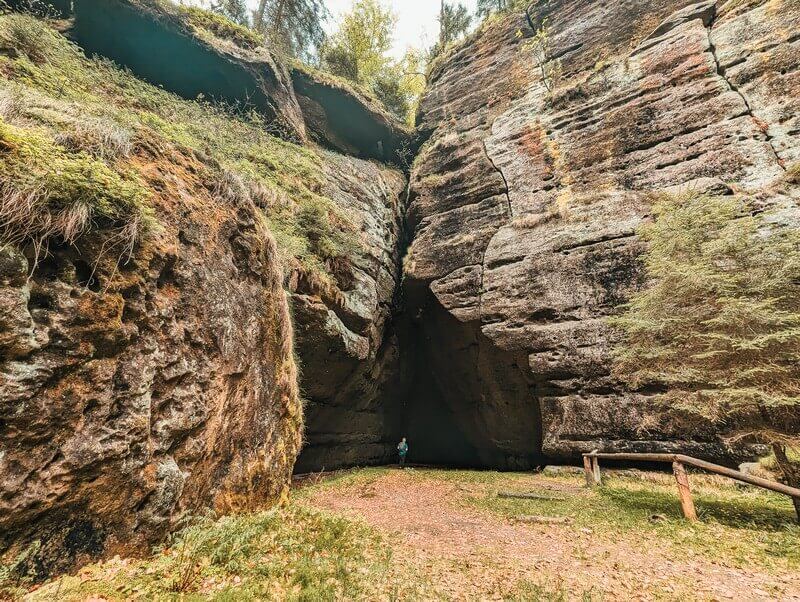
I notice how the air is slowly getting cooler and more humid. Mosquitoes buzz around my face. Step by step, I feel my way along the overgrown path over the slippery stones. Suddenly I see the dark grotto 17 meters deep in the rock. Water is constantly trickling down the curved rocks. A small stone staircase leads to a ledge in front of the cave. I scramble up and sit here for a while, listening motionlessly to the trickling for minutes. The sounds are reflected and amplified by the walls. Then there is the buzzing of the mosquitoes and behind me there is also a trickle of water from another stone. It’s a bit like when a new song comes on Spotify that I like and I play it on a 5.1 surround sound system in a continuous loop – only better.
from my travel notes
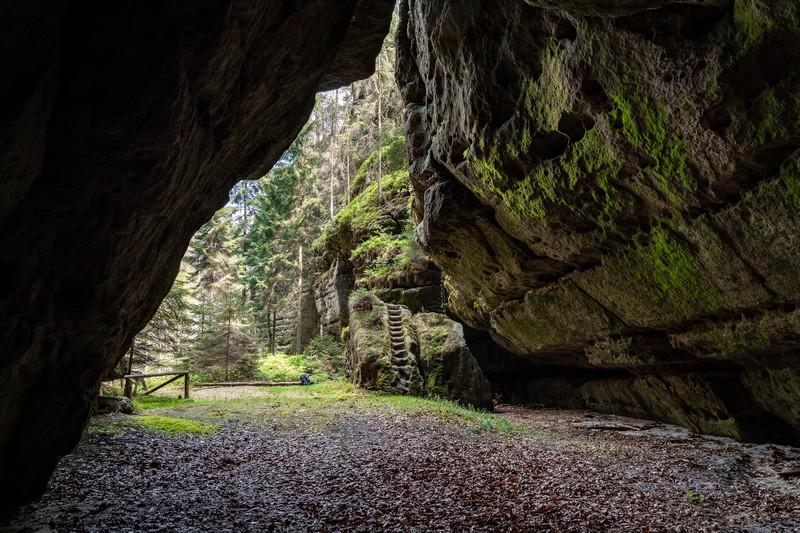
15. Carolafels
At 458 meters high, the Carola Rock is the highest projection of the Affensteine rock group. It is a very popular destination for hikers in the region because of its great views of the landscape.
16. The Kleinhennersdorf caves
A great cave hike awaits you at “Kleinhennersdorfer Stein”, which is also suitable for children. From the Gohrischstein forest parking lot, you walk for around 30 minutes to a rock formation where you will find 3 caves as well as many interesting shapes:
- Ice cave
- Fidget spinner
- and cave of lights
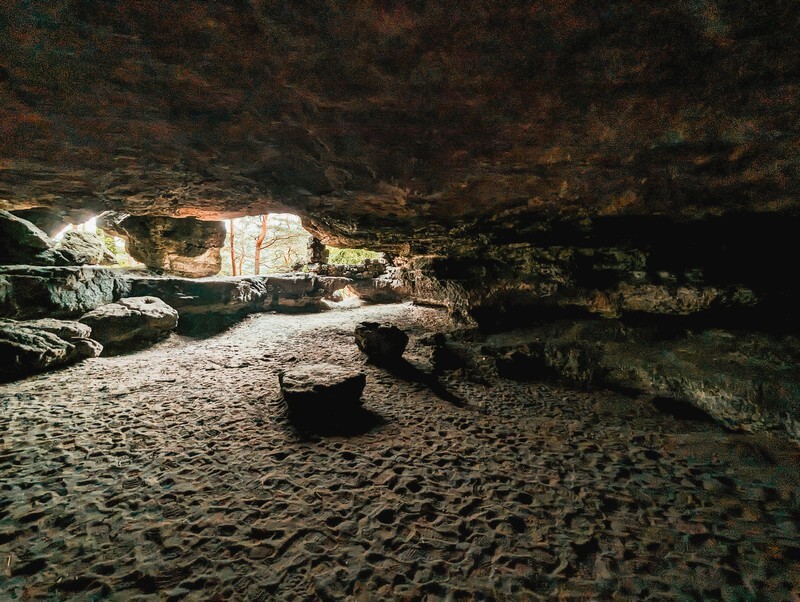
Some of the entrances to the caves are not so easy to find, but searching around is also part of the attraction of visiting this region. It’s best to take a flashlight with you so that you can properly illuminate the rear parts of the caves.
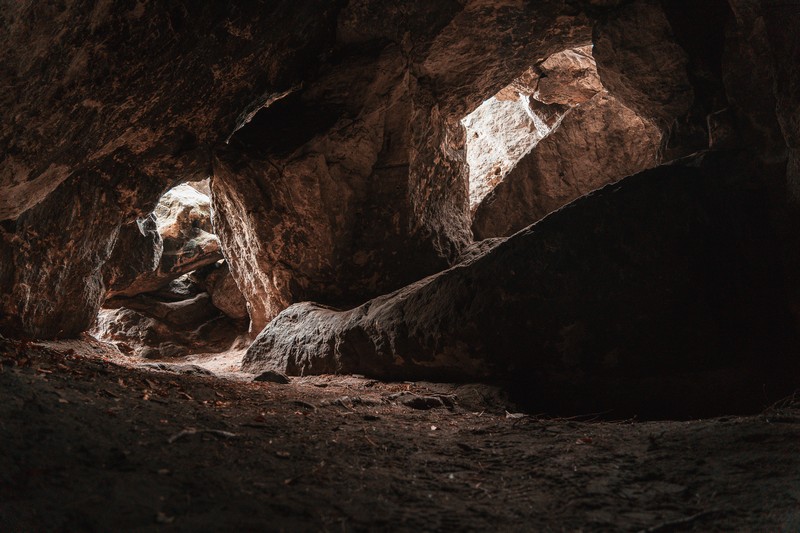
17. Falkenschlucht gorge
From the same forest parking lot from which you reach the caves, you should definitely also walk in the other direction through the Falkenschlucht gorge. This is a very attractive climbing route where you have to climb up or down the narrow rock faces using steps, ladders and railings.
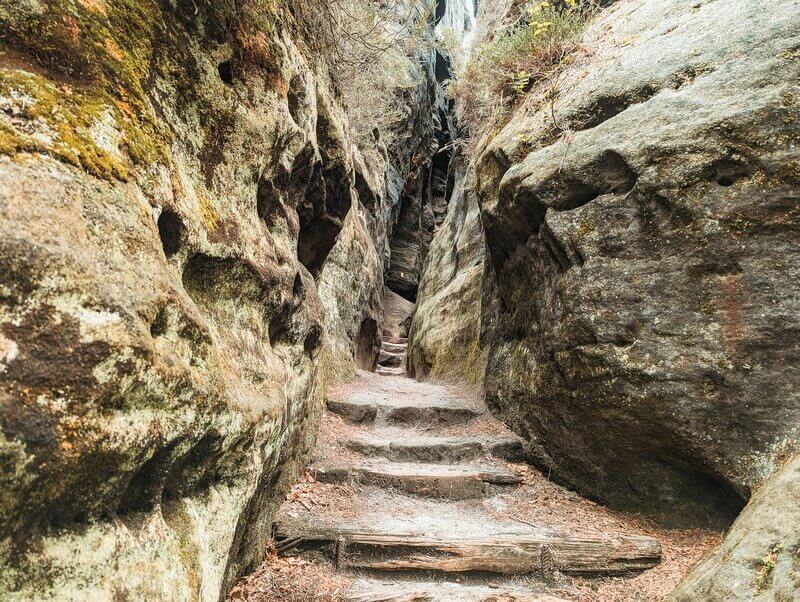
If you find the path too dangerous, there are alternative routes that lead around the outside and require less climbing skills. A day ticket for the Gohrischstein forest parking lot costs €3.
18. Schrammsteine
The elongated rock formation of the Schrammsteine is one of the most famous sights in the eastern part of the Saxon Switzerland National Park.
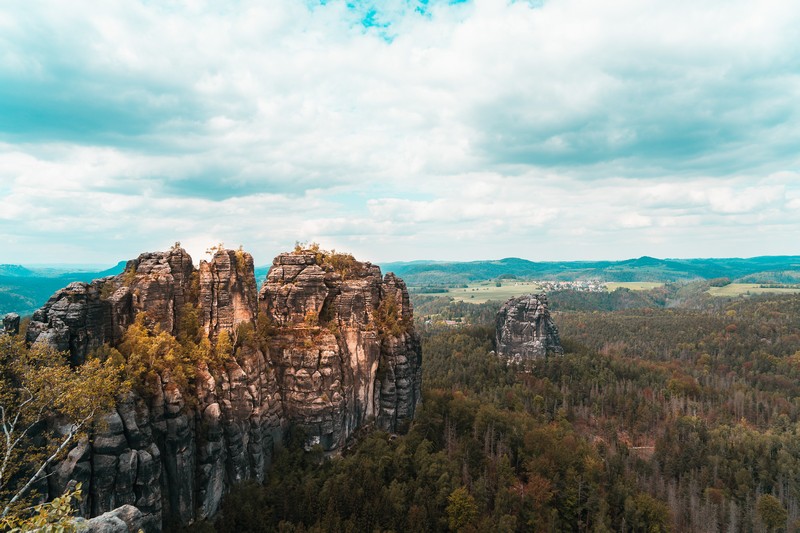
You have the best view if you hike up the hiking trail via the Schrammsteinaussicht. There are several rocky plateaus at the top from which you can enjoy the view. The Schrammsteine are particularly popular at sunset. It is a fantastic spectacle when the setting sun slowly shines down through the Schrammsteine.
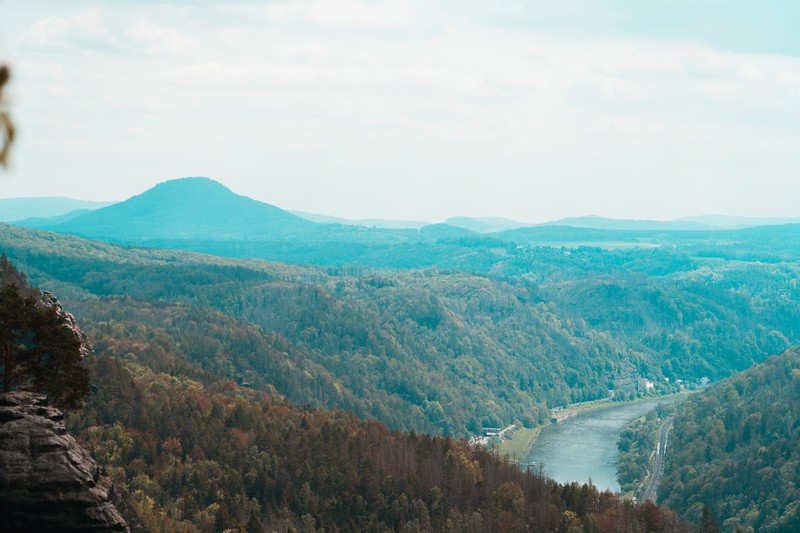
19. Kirnitzschtalbahn streetcar
The Kirnitzschtalbahn is a historic, meter-gauge streetcar that runs 8 km along the Kirnitzsch river from Bad Schandau to the Lichtenhain waterfall. The train’s carriages are around 50 years old and are part of the region’s normal local transport system.

Many tourists use it to commute between Bad Schandau and the stops, which are often the starting point for great hikes. You can find the timetable and prices here.
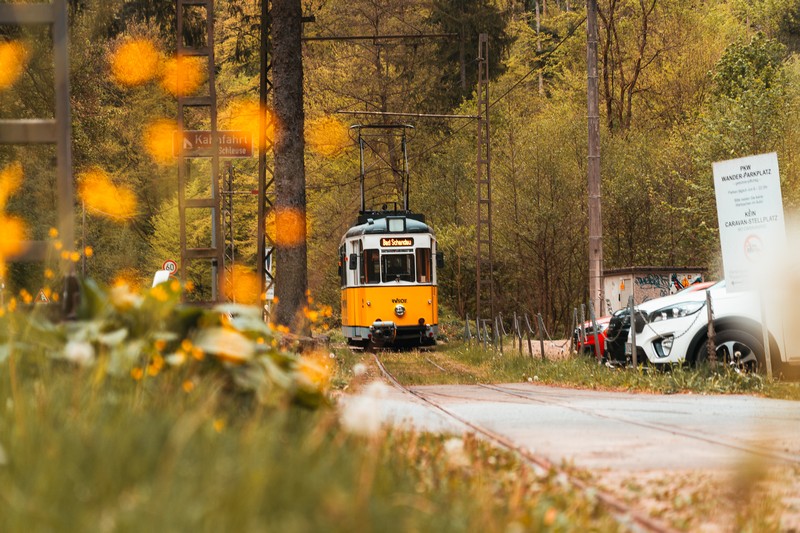
20. Lichtenhain waterfall
The Lichtenhain waterfall was once a popular tourist attraction, that was almost completely destroyed during a heavy rainfall in 2021. Since 2025 it is working again. Also, the adjacent inn is a popular destination for hikers.
And the Kirnitzschtalbahn still has its terminus at the waterfall. From there, an idyllic hiking trail leads up to the “Kuhstall” rock gate, a popular attraction in Saxon Switzerland.
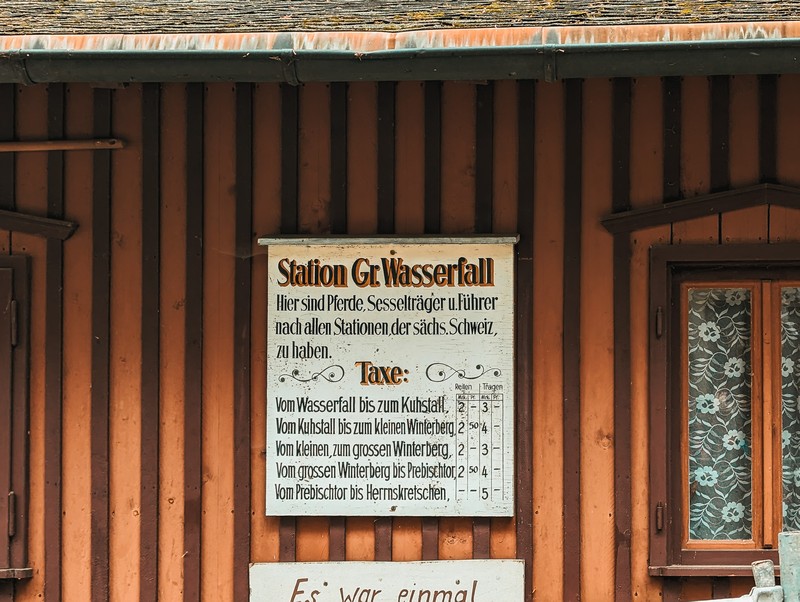
21. Kuhstall (cowshed)
The Kuhstall is a rock gate that was probably used by the inhabitants to hide their cattle during the Thirty Years’ War. At 17 meters wide, 11 meters high and 24 meters deep, the rock gate is quite impressive – especially against the backdrop of the national park with its dense forests, which you have a great panoramic view of from here.
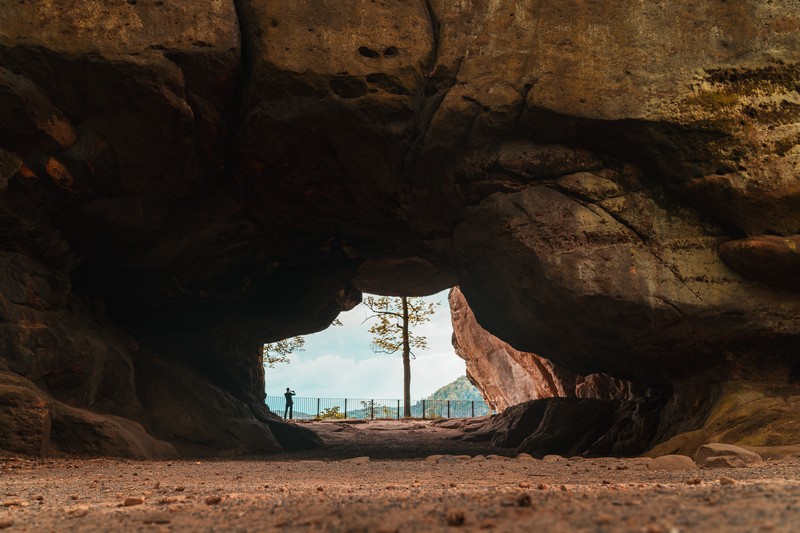
You can reach the top even further via the so-called sky ladder, right next to the rock gate. This is a narrow metal staircase that leads you between two rocks to the top.
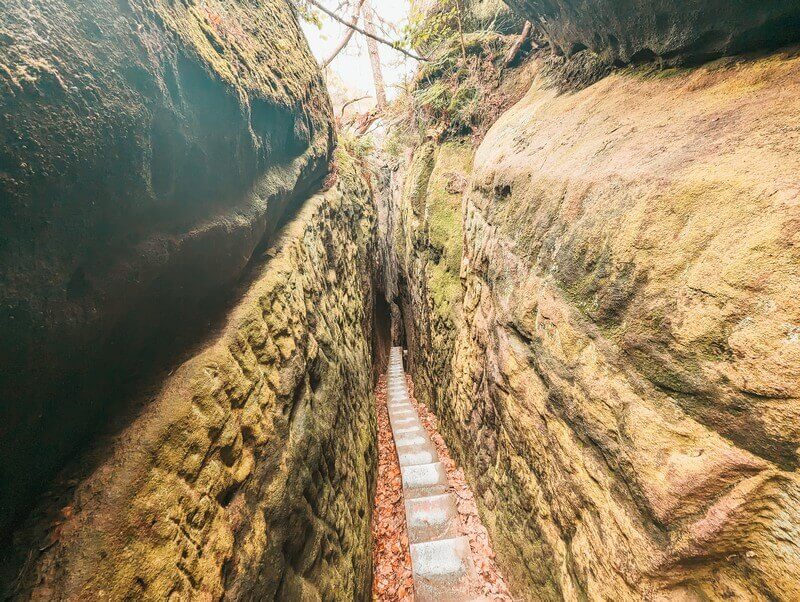
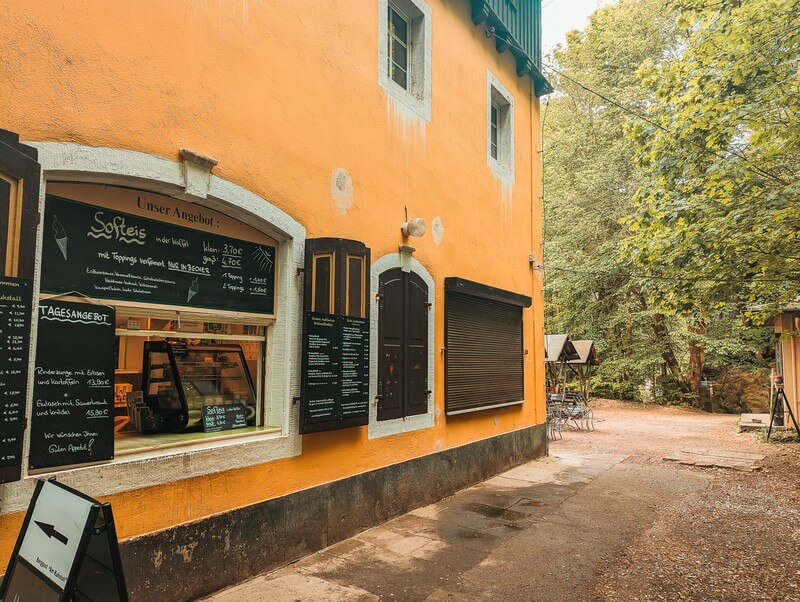
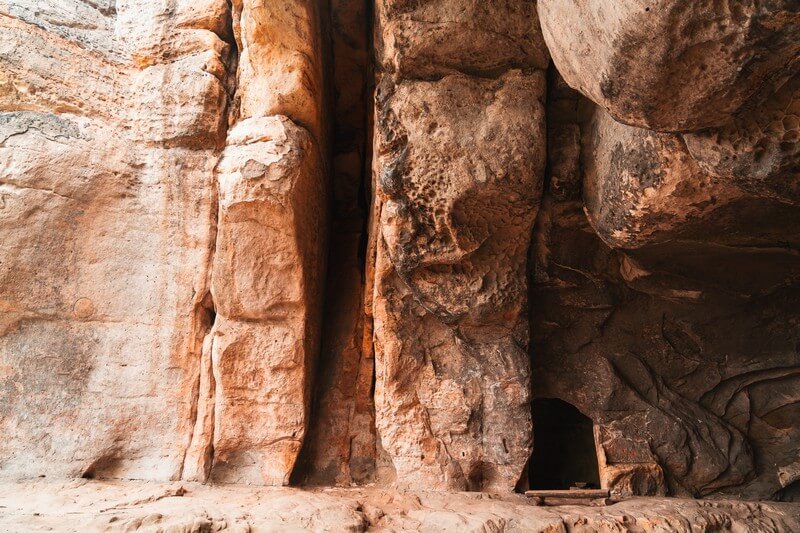
22. rock labyrinth Langenhennersdorf
This attraction is frequently in the news because careless hikers get lost here. There are many crevices, cracks and caves in this region through which the typical iron stairs and steps lead. It’s quite easy to get lost here.
Fortunately, there is a marked path that leads you through the nature reserve . Simply follow the white numbers on the green background. However, you should be careful when it is raining or wet, especially if you are out and about with children. This is because the stones here are slippery and you can easily slip.
23. Barbarine
The Barbarine is one of the most famous freestanding rocks in Saxon Switzerland. The shape of the Barbarine is somewhat reminiscent of a stone needle. It is around 43 meters high. You can reach the Barbarine quite easily via a hiking trail from Pfaffendorf.
Hiking buses in Saxon Switzerland
From March to October , special hiking buses run through the national park operated by Regionalverkehr Sächsische Schweiz-Osterzgebirge GmbH. These buses will take you to many places in the national park to start hikes, even without a car.
Or you can use the buses to plan your tours so that you can get back to your accommodation by bus at the end. Just make sure that the buses stop running at a certain time in the evening.
The departure times are always shown directly on the signs at the stops. You can also find the exact schedules online here.
Cycling in Saxon Switzerland
Although Saxon Switzerland is predestined for hiking, cyclists also get their money’s worth here.
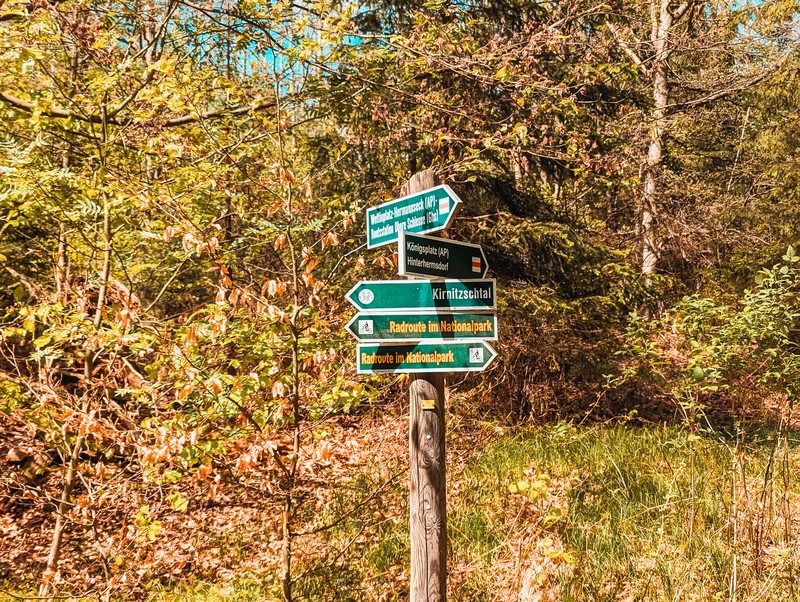
However, you are generally not allowed to cycle on the hiking trails in the national park. However, there is a beautiful cycle route that leads through the forests of the park. These are suitable for trekking bikes, e-bikes or mountain bikes and are always well signposted. There are around 50 km in total and some of them are quite steep.
There is also a very popular cycle route along the Elbe, the Elbe Cycle Path, which takes you 35 km through the Elbe Sandstone Mountains along the river.
Hiking Saxon Switzerland
Of course, Saxon Switzerland is one of the most beautiful regions for hiking in Germany. There are countless routes that all want to be explored.
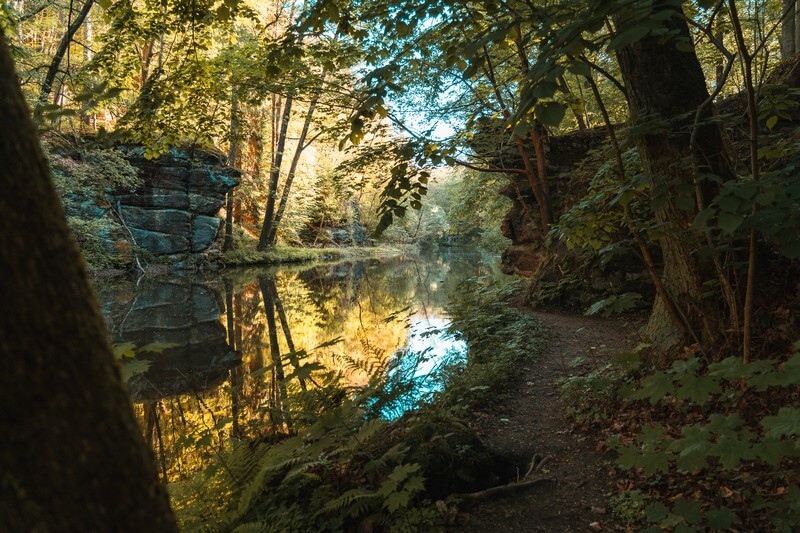
The Malerweg, which many painters once walked along, is particularly famous because there are so many great motifs along the entire route. You probably won’t complete the entire 116-kilometre route. But the trail is divided into various stages, some of which you will also walk along on other hikes.
You should also definitely take a look at the many nature trails. My favorite is the Hohnstein nature trail.
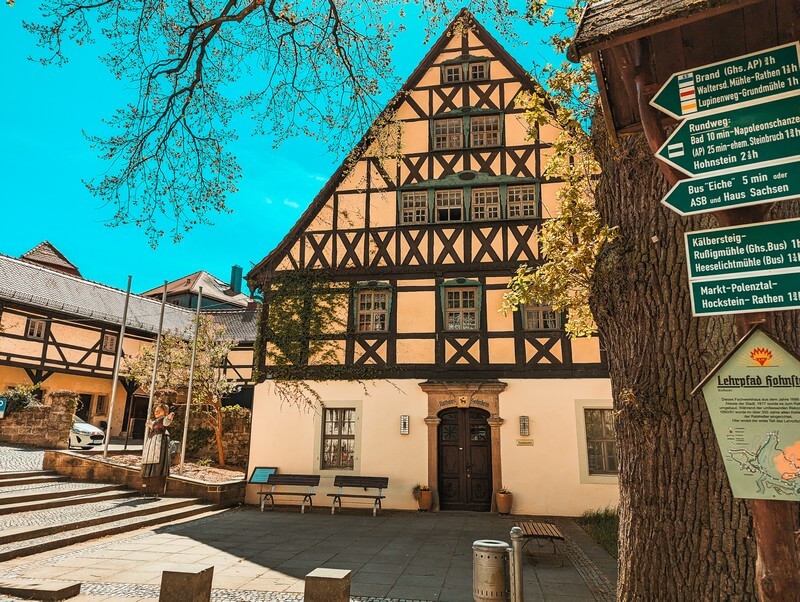
I would recommend that you don’t do too much at once. I recommend a maximum of 20 km a day. You’ll be well served with that and easily have 5 – 6 hours of pure hiking. Then of course there are breaks for photos and to eat and drink.
For navigation, I recommend a Saxon Switzerland hiking guide. It will show you the best routes and often includes extensive maps:
- Saxon Switzerland National Park Travel Guide 2025
- GERMANY, Saxony Switzerland National Park and Malerweg Trail, hiking maps
Once you’re there, you can also use an app that gives you access to the Open Street Map, e.g. Outdoor Active. This will show you all the hiking trails. Google Maps, on the other hand, is very unsuitable for hiking.
Cool hotels in Saxon Switzerland
The Laasenhof Resort is perfectly located between Königstein and Rathen. From here, you can quickly reach the Bastei Bridge or Königstein Fortress, and it’s also not far to the other sights of Saxon Switzerland and the hiking trails. The Rauenstein is in the immediate vicinity.
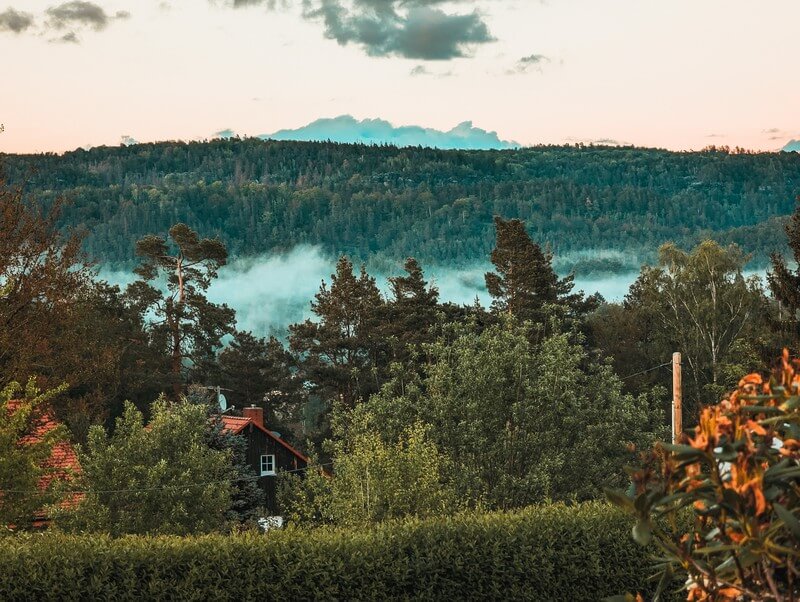
The 4-star Hotel Quartier 5 is located in the spa town of Gohrisch and is housed in a restored country inn. There is a well-known restaurant, a bar and a bistro here. If you need a little more comfort while hiking, this hotel is a good choice for you.
The best campsites and motorhome pitches in Saxon Switzerland
There are several camping and motorhome sites in Saxon Switzerland. I can recommend the “Thorwaldblick” campsite in Hinterhermsdorf. From here you can go on many hikes into the depths of the eastern national park.
Another great option is the Struppen camping site. It is located on a hill in Rathen and you can see as far as Königstein Fortress from here. Rathen is also only around 30 minutes away by bike

There are also some campsites along the Elbe, which are certainly a good alternative. However, the rails also run along here and as many freight trains run along this route, these campsites are not for campers who need absolute peace and quiet.
What other Saxon Switzerland sights and tips are missing from this list? Write them in the comments.
Tools & services I recommend for your trip:*
📶 Flexible and affordable mobile Internet worldwide
🚁 My drone for aerial photography
🚗 Find and compare cheap rental cars
🎟 Find and book cool activities
🔒 Secure Internet connection with NordVPN
*Note: These links are affiliate links. If you book through them, I will receive a small commission without it being more expensive for you. A purchase from you via these links helps me to continue offering free content without annoying ads on this website. Thank you for your support! I really appreciate it!

